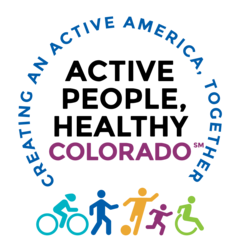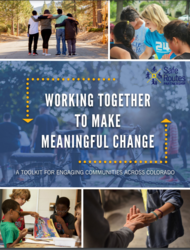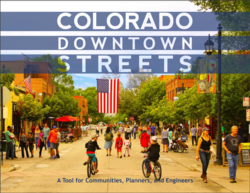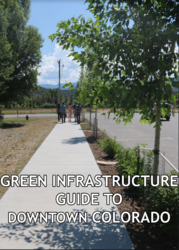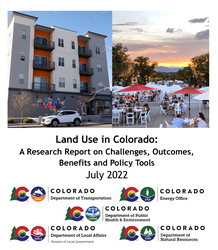Built environment
Public health and the built environment
The built environment is the layout and design of a community’s buildings, streets, sidewalks, and infrastructure and includes the spaces and places where people live, learn, work, play, and recreate. The built environment shapes daily experiences and can impact a person’s physical, mental, and social well-being.
The built environment can promote health by:
- Increasing rates of physical activity through safe, accessible, and continuous sidewalks, bicycle facilities, transit routes, parks, and trails that connect to everyday destinations such as schools, jobs, parks, homes, and grocery stores.
- Increasing fruit and vegetable consumption through access to healthy food options including community gardens, farmers markets, and urban agriculture.
- Reducing risk of asthma and respiratory diseases from environmental exposures through green infrastructure, multi-modal transportation options, healthy housing, and land use and zoning policies.
- Promoting social connectedness through safe, accessible, activity-friendly transportation routes, access to public gathering spaces, green spaces, and recreational opportunities.
The Elements of a Healthy, Equitable Community developed by ChangeLab Solutions illustrates how elements such as safe and connected transportation systems, affordable housing, healthy food, parks, and environmental quality can provide health and equity benefits.
Source: ChangeLab Solutions
CDPHE works collaboratively with state agencies and community partners across multiple sectors to advance evidence-based built environment policies and strategies designed to reduce the overall prevalence of chronic diseases and improve the health of all Coloradans by:
- Partnering with communities on policy and environmental changes such as safe and stable housing, parks, transportation, food access, alcohol outlet density, and community resiliency.
- Using health and equity data to better understand and communicate the relationship between health and the conditions of neighborhoods and the built environment and influence the distribution of resources to communities with the greatest needs/health disparities.
- Encouraging local governments to integrate health and equity into community priorities, leveraging community expertise in the planning process, and assisting local jurisdictions in identifying and implementing model land use and zoning policies that address health inequities.
Steph Leonard, MPH, MURP, Built Environment Coordinator
- Email: Steph.Leonard@state.co.us
Liz Young-Winne, MPH, AICP (MURP), Built Environment Coordinator
- Email: Liz.YoungWinne@state.co.us
Bradyn Nicholson, MPH, MURP, Built Environment Coordinator
- Email: Bradyn.Nicholson@state.co.us
Cate Townley, MURP, MUD, Senior Built Environment Specialist
- Email: Cate.Townley@state.co.us
Success stories
CDPHE’s Built Environment program awards quick-win funding to communities across Colorado for low-cost, locally-driven projects that promote physical activity and active transportation, increase safety and enhance streetscapes through equipment or public art. This funding supports local efforts to enhance activity-friendly routes connecting to everyday destinations such as schools, jobs, food sources, parks, and recreation and helps build momentum toward implementing built environment policy changes.
- Success stories. (Google Drive folder)
Built environment resources
A collection of resources created collaboratively with CDPHE’s built environment team and state and national partners to support health and equity through the built environment.
Toolkit for engaging communities across Colorado
The Working Together to Make Meaningful Change: Toolkit for Engaging Communities across Colorado is a resource developed through a partnership between CDPHE, the Colorado Department of Transportation (CDOT), and the National Safe Routes Partnership.
The toolkit features an engagement framework centering on those who live, work, and play in the community at the heart of the process. It walks through each step of the engagement framework in detail and offers creative ideas for engagement activities and strategies for sustaining community engagement long-term.
Colorado Downtown Streets
Colorado Downtown Streets is a resource developed through a partnership between CDPHE, CDOT, and the Colorado Department of Local Affairs (DOLA).
It's an easy-to-digest resource helps local leaders, community members, and technical professionals work together to create better streets by providing creative and flexible design approaches for increasing safety for all street users and modes of travel along downtown streets.
- Colorado Downtown Streets (2020). (PDF)
Guide to Downtown Colorado
Green Infrastructure Guide to Downtown Colorado is a resource that was developed through a partnership between CDPHE and CDOT.
The guide introduces and identifies green infrastructure best management practices for downtown streets. It is an expansion of the Colorado Downtown Streets publication and considers stormwater management and the benefits of adding vegetation on downtown streets.
Land Use in Colorado: A Research Report on Challenges, Outcomes, Benefits and Policy Tools
Land Use in Colorado: A Research Report on Challenges, Outcomes, Benefits and Policy Tools is a report developed through a partnership between CDPHE, CDOT, DOLA, Colorado Energy Office (CEO), and Colorado Department of Natural Resources (DNR).
The report provides a broad survey of community development and land use issues in Colorado, including current land use policies, practices, and challenges.
Additional resources
Additional built environment resources and programs help guide our work with interagency partners. The Built Environment team supports the implementation of the priorities, strategies, and recommendations within these resources.
State-level resources and programs help guide built environment work with interagency partners. The CDPHE Built Environment team supports the implementation of the priorities, strategies, and recommendations outlined in these planning documents and programs.
- CDPHE BE. (Google Sheet)
National resources lead to external national resources that frame and guide CDPHE’s built environment work.
CDC Active People, Healthy Nation
- Active People, Healthy Nation is a national initiative led by the Centers for Disease Control & Prevention to help 27 million Americans become more physically active by 2027.
- Active People, Health Nation. (CDC website)
CDC Strategies to Increase Physical Activity
- In alignment with Active People, Healthy Nation, this site provides communities with evidence-based strategies to increase physical activity across sectors and settings.
- Strategies for Increasing Physical Activity. (CDC website)
Bay Area Regional Health Inequities Initiative (BARHII) Framework
- BARHII developed a conceptual framework that illustrates the connection between social inequalities and health, and focuses attention on measures that have not characteristically been within the scope of public health department epidemiology.
- BARHII. (Bay Area Regional Health Inequities Initiative (BARHII) website)
Data can help tell the story of how the built environment impacts health and equity and can support data-driven decision-making. The data sources section of the spreadsheet can help identify communities and priority populations experiencing the greatest health inequities across Colorado and allocate resources to these areas/groups to identify and implement the evidence-informed strategies best suited to address their needs.
- CDPHE BE. (Google Sheet)
The funding section lists recurring funding opportunities specific to built environment efforts by topic area including:
- transportation
- parks
- trees
- community spaces
- affordable housing
- safe and decent housing
- access to healthy food
Resources
- CDPHE BE. (Google Sheet)
Explore additional built environment programs and resources.
- Built Environment resources. (Google sheet)
